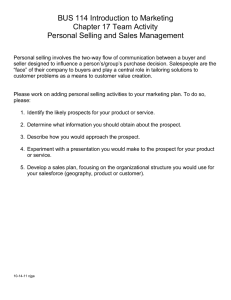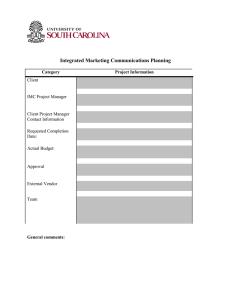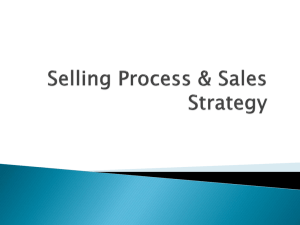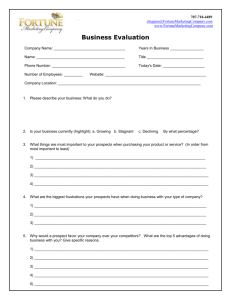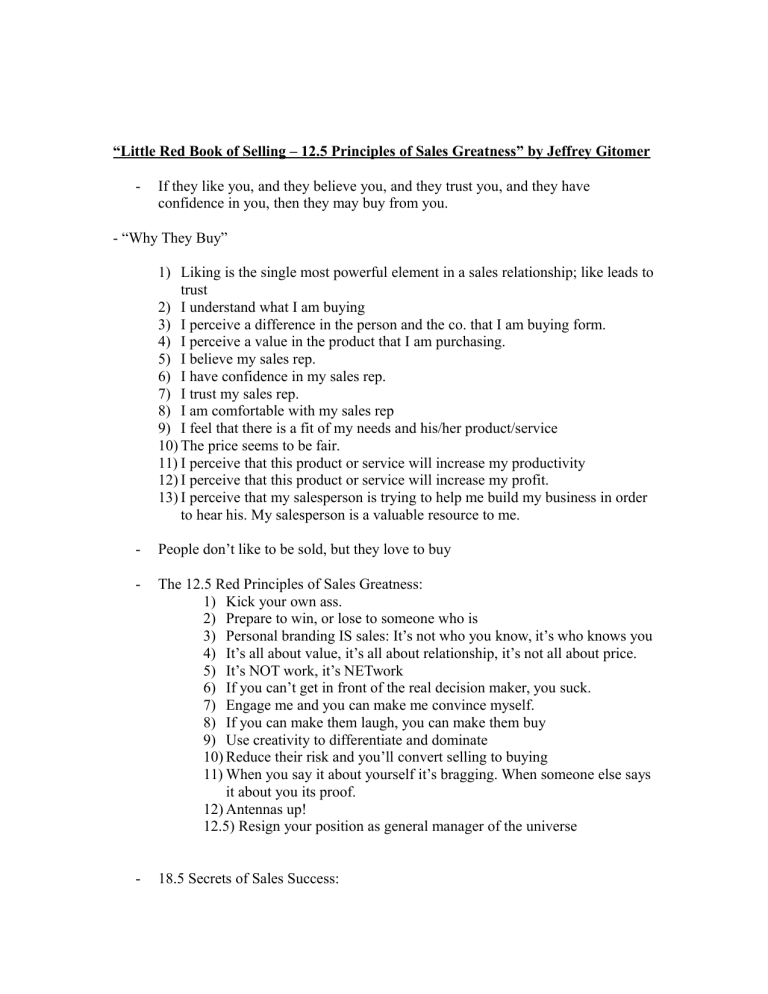
“Little Red Book of Selling – 12.5 Principles of Sales Greatness” by Jeffrey Gitomer - If they like you, and they believe you, and they trust you, and they have confidence in you, then they may buy from you. - “Why They Buy” 1) Liking is the single most powerful element in a sales relationship; like leads to trust 2) I understand what I am buying 3) I perceive a difference in the person and the co. that I am buying form. 4) I perceive a value in the product that I am purchasing. 5) I believe my sales rep. 6) I have confidence in my sales rep. 7) I trust my sales rep. 8) I am comfortable with my sales rep 9) I feel that there is a fit of my needs and his/her product/service 10) The price seems to be fair. 11) I perceive that this product or service will increase my productivity 12) I perceive that this product or service will increase my profit. 13) I perceive that my salesperson is trying to help me build my business in order to hear his. My salesperson is a valuable resource to me. - People don’t like to be sold, but they love to buy - The 12.5 Red Principles of Sales Greatness: 1) Kick your own ass. 2) Prepare to win, or lose to someone who is 3) Personal branding IS sales: It’s not who you know, it’s who knows you 4) It’s all about value, it’s all about relationship, it’s not all about price. 5) It’s NOT work, it’s NETwork 6) If you can’t get in front of the real decision maker, you suck. 7) Engage me and you can make me convince myself. 8) If you can make them laugh, you can make them buy 9) Use creativity to differentiate and dominate 10) Reduce their risk and you’ll convert selling to buying 11) When you say it about yourself it’s bragging. When someone else says it about you its proof. 12) Antennas up! 12.5) Resign your position as general manager of the universe - 18.5 Secrets of Sales Success: 1) Believe you can. 2) Create the environment. 3) Have the right associations – hang around the right people. Other successful people. Have a mentor or three. 4) Expose yourself to what’s new. 5) Plan for the day. Prepare with education. Plan with goals, and the details for their achievement. 6) Become valuable. Give first. 7) Have the answers your prospects and customers need. Propsects don’t want facts, they want answers. In order to have answers you must have superior knowledge about what you do – and explain it in terms of how the prospect uses what you do. 8) Recognize opportunity. 9) Take advantage of opportunity. 10) Take responsibility. 11) Take action. 12) Make mistakes – best teacher is failure. 13) Willing to risk. 14) Keep your eyes on the prize. Post your goals. Stay focused on your dreams and they will become reality. 15) Balance yourself. Physical, spiritual, and emotional. 16) Invest don’t spend. 17) Stick at it until you win. Most people fail because they quit too soon. Make a plan and a commitment to see the plan through – no matter what. 18) Develop and maintain a positive attitude. 18.5)Ignore idiots and zealots. - Failure – learn from it or ignore it. Failure actually only occurs when you decide to quit. You choose your results. Things you can do to avoid getting to the “quit” stage: o Look at failure as an event, not a person o Look for the why, and find the solution o List possible opportunities. o Ask yourself, what have I learned? And try again. o Don’t mope around with other failures – go find a successful person and hang around him. Principle 1: Kick Your Own Ass - study voicemail presentation skills self-inspiration self-determination hard work; most salespeople will not do the hard work that it takes to make selling easy. - When you’re in a slump, you begin to press for orders instead of working your best gameplan, which is “sell to help the other person”, and let your sincerity of purpose shine through. When you have the pressure to sell, the prospect senses it, and backs off. - To fix slumps: o o o o o o o o o o o o o o o o o o o o - Study basics Revisit our plan for success – Today List 5 things you could be doing to work smarter and harder Change your presentation – take the customer’s perspective Talk to your five best customers Get someone you respect to evaluate your presentation, take them with you on sales calls. Visit your mentor Get to work an hour before everyone Stay away from pity parties Hang around positive, successful people Have some fun Spend 30 minutes a day (in the morning is best) reading about your positive attitude Listen to your favorite song just before the presentation Take a day off Rearrange your office Audiotape your presentations live Videotape your presentation Take the best salespersons you know out on calls with you for a day. Take your boss with you on calls for a week. Avoid negative talk and negative people like the plague celebrate effort, not victory. Time management – lessons in time management are pretty much a waste of time. You know what to do. You even know when to do it. What you need is a lesson in procrastination. Principle 2: Prepare to Win, or Lose to Someone Who Is - Be prepared! “Tell me a little bit about your business?” – how unprepared does that make you look? Other dumb things to say: “Let me tell you a little about my business” - Preparation Resources: o Internet o Their literature o Their vendors o Their competition o Their customers o People in your network who may know them o Their other employees o The best and least used resource: Their sales department o Google yourself - Be prepared with an objective or two about what you want to accomplish in the meeting. “They make the fatal error of getting all their own stuff ready. PowerPoint slides, samples, literature, business cards – you know, all the same things the competition is doing. Biggest mistake in sales. And almost every salesperson makes it. Do your homework. The workday starts the night before. Work while others sleep. - Principle 3: Personal Branding Is Sales: It’s Not Who You Know, It’s Who Knows You - Establish yourself as an expert Build your image - Develop a personal brand: o Register your name.com (obtainyourname.com) o Be willing to give of yourself—first o Dedicate time to make it happen o Get others to help you. – List the people you think can help you or help you connect – and ask for their support. o Make a brief 30-second commercial – about what you do and how you can help others. Deliver it AFTER you have asked the other person what they do. o Combine outreaches – i.e., donate a scholarship to the trade association of your best client. o Do everything with a creative flair. o o o o o o o - Get the best business card money can buy. Stay in front of the people you want to do business with. Become a resource. Persistence and consistency are the secrets. Have a good time doing it. Strive to be the best at whatever you do. Ignore idiots and zealots. Build your personal brand and customers will call you. Build your personal brand and customers will be loyal. The integrity of my brand is the consistency and the value of the message. Principle 4: It’s All About Value, It’s All About Relationship, It’s Not All About Price - Give first, don’t keep score Make friends before you start, or don’t start Act professionally, talk friendly - I put myself in front of people who can say “yes” to me and I deliver value first. - The 6.5 Principles of giving value and being valuable: 1. Market with stuff and information about prospects and customers – not about you. Send them information about how they profit, produce or succeed, and they will devour EVERY WORD. 2. Write (good) stuff in journals, newspapers, e-zines, and newsletters. 3. Create response vehicles or mechanisms in everything you write. 4. Earn your way onto every broadcast media possible. 5. Get known as a person of value. 6. Send you stuff after they ask for it, and make sure it has something they will keep. Proactive mailings rarely work. 6.5 Speak in public or cold call? - give a free speech at a civic group. - the best way to market yourself is give yourself to the market - 6.5 Success Tactics of Free Speech - Don’t give a sales pitch, but do speak on your topic. - Pick a great audience. - Give a handout. - Videotape it. - Ask for audience evaluations. - Give value, get leads. At the end of your talk, offer something additional for free in exchange for their card. 6.5 Hang around after the meeting. - Price Vs. Value - “Our prices are guaranteed to be $100 more than anybody else’s price, but our service is guaranteed to be 100% better than anybody else’s service.’ 1. Stop thinking of your product as a commodity. It’s all about the relationship. 30-40% will buy price. The good news is 60-70% of all customers will buy value if you provide it to them. 2. Take the last 10 sales that you made and try to discover the following: How was the sale completed? 3. Don’t focus on the sale, focus on the lifetime use of the product or service. 4. Start your sales call at a higher level. Principle 5: It’s Not Work, It’s NETwork - What do you need to be a successful networker? - A great 30-second commercial that engages and asks questions that qualify the prospect, and gets to the next step in the sales cycle if there’s an interest. - Your willingness to dedicate the time it takes to do it and be excellent at it. - A plan of where and when. - To maximize your networking effectiveness, you must follow one simple rule: Go where your customers and prospects go, or are likely to be. Examples: - Chamber of Commerce business event after hours. - A high level Chamber of Commerce Event. - Any Business Journal Event. - A networking club or business organization where solid business contacts belong and participate. - Someplace where like-minded people belong. - Any type of class you take to learn more and make yourself better. - A civic organization. Rotary, Kiwanis, Elks, Moose, Lions. - Attend a cultural event. The theater and the symphony attract people with class and money. - Get involved with a charity or be a community volunteer. - Your trade or professional association. - Your best customer(s) trade or professional association. Be a seminar presenter, not just an attendee. - Trade shows. - Join a private club. A golf country club, etc. - Meal networking. “Own a restaurant or three. - Health Club - Sports events. - Parents of your children’s friends. - - Happy Hour. - Karaoke. - Neighborhood homeowner’s association/condo association. - The airplane. 21.5. Being ready to network when you get there. Principle 6: If You Can’t Get in Front of The Real Decision Maker, You Suck - Why are you not setting appointments? - You couldn’t sell them on “yes” – they sold you on “no” The appointment is the fulcrum point of the sale – you can’t sell squat without a face-to-face or phone-to-phone appointment with the decision maker. Don’t sell the product, don’t sell the service, sell the appointment. You need to become an expert in the industry or categories you cover, you need to know where your prospect or customer uses your product or service to build their business and make a profit. You have to know something about them. You have to be brief. You can’t sell more than an appointment. Don’t ask, “How are you today?”, or “Have you ever heard of us?” You Engage – the heart of the appointment process is the engagement. Ask compelling and engaging questions. Do not save the prospect money, earn the prospect profit. Start higher on the decision-making chain than you dare. It’s not a benefit statement. It’s a profitability statement. It’s not a benefit statement. It’s a productivity statement. The do not want to be or need to be educated. They want answers just like you do. Offer answers as a reason to meet, and the appointment is yours. “I only need on more approval and the order is yours” must trigger your response to the prospect, “Great, when do we all meet?” 1. Get the prospect’s personal approval. “Mr. Prospect, if it was just you and you didn’t need to confer with anyone else, would you buy? (they will almost always say yes.) Then ask, “Does this mean you’ll recommend our service to the others?” 2. Get on the prospect’s team, talk in terms of “we” 3. Arrange a meeting with all deciders 4. Know the prime decider in advance. 5. Make your entire presentation again. - The most powerful qualifying question you can ask, “Bill, how will this decision be made? Bill will give you an answer, you follow up with: “Then What?” And Bill will begin to give you the saga about how the decision is really made. You ask, “then what?” four or five times and presto! You’ll have the name of the real decision maker. - Real salespeople sit in front of real decision makers. How real are you? - Voicemail strategy: Leave half a message, pretend like you’re cut off and hang up Have kids leave message The secret to voicemail is be slightly daring and take risks Principle 7: Engage Me and You Can Make Me Convince Myself - - - The most important aspect of making a sale is also a major weakness of every salesperson. Asking questions. The first personal (rapport) question sets the tone for the meeting, and the first business question sets the tone for the sale. Benefits of asking the right question: - Qualify the buyer - Establish rapport - Create prospect disparity - Eliminate or differentiate from the competition - Build credibility - Know the customer and their business - Identify needs - Find hot buttons - Get personal information - Close the sale Do you have 25 questions – the most powerful questions you can create – 95% of all salespeople don’t. Challenge: Get every prospect and customer to say, “No one ever asked me that before” 7.5 Questioning Success Strategies: - Ask prospect questions that make him evaluate new information. - Ask questions that qualify needs. - Ask questions about improved productivity, profits, or savings - Ask questions about company or personal goals - Ask questions that separate you from your competition - Ask questions that make the customer or prospect think before giving a response - Ask POWER QUESTIONS to create a BUYING atmosphere, not a selling one 7.5 A critical success strategy: To enhance your listening skills, write down answers. It proves you care, preserves your data for follow-up, keeps the record straight, and makes the customer feel important. Secret to formulating a power question: - A question that makes them think (and respond) about me in terms of the prospect. - Bad examples: What type of life insurance do you have? Good examples: If your most important customer called right now, how would you get the message? - A sale is made or lost based on the questions you ask. Your answers are in your questions. - A few Power Question lead-ins… - What do you look for… - What have you found… - How do you propose…. - What has been your experience…. - How have you successfully used…. - How do you determine… - Why is that a deciding factor… - What makes you choose… - What do you like about… - What is the one thing you would improve about… - What would you change about…(Don’t say, “What don’t you like about…?) - TO DO: questions must be thought out and written down in advance. Develop a list of 15-25 questions that uncover needs, problems, pains, concerns, and objections. Develop 15 to 25 more that create prospect commitment as a result of the information you have uncovered. - Dumbest questions: - Who are you currently using… - Are you satisfied with your present… - How much are you currently paying for… - Can I quote you on…. - Can I bid on… - Tell me a little bit about your business… - Are you the person who decides about… (why ask a question that breeds misleading information) correct question is: How will the decision be made? - What would it take to get (earn) your business? - Dumb words: today, frankly, honestly, if I were you, or anything negative about the previous choice they made, or anything negative about your competition Asking powerful questions will make prospects think in new ways. You want to understand their motives for buying. Your questions are a critical factor in the way your customers perceive you. - Principle 8: If You Can Make Them Laugh, You Can Make Them Buy! - making people smile or laugh puts them at ease and creates an atmosphere more conducive for agreement. Pick something that’s funny to you, personal to you Develop lines that are tested to make people laugh Keep the lines clean. Real clean. Poke fun at yourself. Don’t drag it out. Take small humor risks. - making people smile is a major key in selling. - Safe topics: - - - - Children (what they did or said) Traffic (what you did or saw) Repeating a sit-com or television line Self-stuff Self-abilities Self-improvement Laughter is mutual approval, and mutual approval is at the fulcrum point of selling. Study humor 1) visit comedy clubs 2) watch comedys 3) read joke books 4) join toastmasters 5) watch and listen to children very carefully 6) Read history 7) Take humor risks where you don’t have much to lose 8) Take a professional comedian to lunch 9) Practice making funny faces 10) Get our your high school yearbook 11) Take an acting class 12) Carry audiotapes of your favorite comedians 13) Start looking for humor in every day life 14) Practice exaggerating your getsutres 15) Hang around funny people 16) Laugh a lot You use humor when you’re the master of knowing your own product, knowing your customer and his business, and knowing the science of selling. If you only use humor and don’t know the other three elements, then you will be a clown who makes no sales. Stories are a good way to use humor. Principle 9: Use Creativity To Differentiate and Dominate Elements that drive and/or inspire creative process: 1) 2) 3) 4) 5) Brains Attitude The habit of observing The habit of collecting ideas Your self belief – If you tell yourself you are creative, more creative things will happen 6) Support system – surround yourself with people who encourage you. 7) The creative environment 8) Creative mentors and associations 9) Studying creativity – THINKERTOYS 10) Studying the history of creativity in your industry 11) Using creative models a. SCAMPER (Substitute, Combine, Adapt, Modify, Maximize, or Minimize, Put to other use, and Reverse or Rearrange. 12) Risk Failure – all creative people take risks 13) Seeing your creativity in action - - - - Three Areas to Make a Difference 1) Your opening question on a sales call – ASK A SMART QUESTION IMMEDIATELY, AND THEY IMMEDIATELY THINK YOU’RE SMART 2) Change your ordinary imaging and branding. 3) Use your follow-up and “stay-in-front-of” power to the MAX – create value, email a weekly tip FIX YOUR VOICE MESSAGE TODAY: - “I’m either on my phone or away from my desk.” (no kidding? Pathetic) Voice message is America’s sales enigma. Everybody has it and 9,999 out of 10,000 have a pathetic message. IDEAS to spice up your voicemail. - 1) A short message about value or profit point of your product. - 2) A thoughtful quote – internet will give you millions - 3) Celebrity impersonation - 4) Your kid - 5) Something funny in general - 6) Something funny about your product or your business - 7) A testimonial from a customer - 7.5) Something off the wall Change the message often Creative approach to ending, “we’re satisfied with our present supplier” forever. - Say, “Mr. Jones, I make a lot of sales calls to prospective new customers and most of them tell me ‘I’m satisfied with who we’ve got.’ Our customers are ecstatic, getting incredible value, are more productive, and are reaping the profits of doing business with us. Would you rather be ecstatic and more profitable or satisfied?” The customer will say, “ecstatic and more profitable.” “Great,” you say. “I came here today HOPING that you were satisfied with who you’ve got.” Take away the objection BEFORE they have a chance to voice it. Principle 10: Reduce Their Risk, And You’ll Convert Selling to Buying - The biggest barrier to a sale is the unspoken risk that a prospect perceives 5 questions as they relate to your product or sale” - 1) What is the definition of risk? - 2) What is the cause of risk” - 3) How much risk am I asking my prospects to take when they make a purchase? - 4) How do I uncover risk factors? - 5) How is risk taken away, removed, or eliminate? - Know their tolerance for risk taking. Ask about previous purchases. Know your risks of purchase. There are less than 10. List them and have “risk removing” answers for them. List what your prospect has to lose if they buy. List the corresponding (or canceling) gains if they buy. Ask your prospect, “What’s the risk?” Then ask, “What’s the reward?” If the risk is low, and the reward is high, then the decision is obvious. - Risk Removal is a POWERFUL CLOSING TOOL - Add piece of mind – directly address a risk that could be concerning them - What to do: - 1) Identify your risks 2) Create GREAT corresponding risk removers or even preventers 3) Try them out on prospects who resist for no stated reason. 4) Master them so that your prospects buy more often 4.5) Teach them to everyone - The biggest risk barrier to a sale is the unspoken risk that a prospect perceives. - Take more chances than you dare. You’ll make more sales than you expect. Principle 11: Use When You Say It About Yourself, It’s Bragging. When Someone Else Says It About You, It’s Proof. - Testimonials – the single most powerful method of making a sale. And also the single most wasted resource in creating a marketing message. To be most effective, testimonials need to have a specific message. Testimonials should be used at the end of the sales cycle to dispel any doubt, reduce all risk, substantiate value, and pave the way to the order. Take your best customer with you on your next sales call. A video picture is worth a sale Asking a customer to tell you their reasons for purchasing from you will get you hundreds more sales of the same type. Buying motives are 1,000 times more powerful than selling skills. Make that 10,000. Principle 12: Use Antennas Up! 6 Positive Sales Senses: 1) The sense of confidence 2) The sense of positive anticipation (thinking you can is 50% of the outcome) 3) The sense of determination 4) The sense of achievement 5) The sense of wining. The will to prepare to win must exceed the will to win. 6) The sense of success 8.5 Negative senses: 1) The sense of fear 2) The sense of nervousness 3) The sense of rejection 4) The sense of procrastination or reluctance 5) The sense of justification/rationale 6) The sense of self-doubt 7) The sense of uncertainty 8) The sense of doom 8.5) The sense of “I’m unlucky” Principle 12.5: Resign Your Position As General Manager of The Universe
